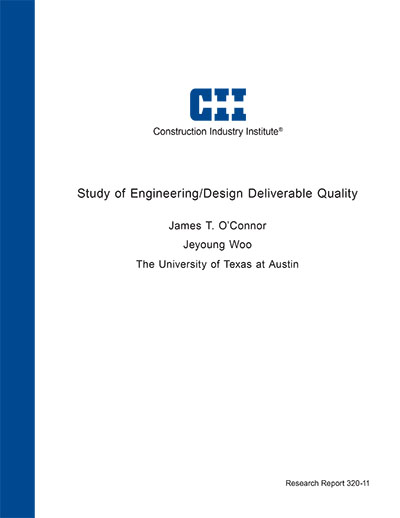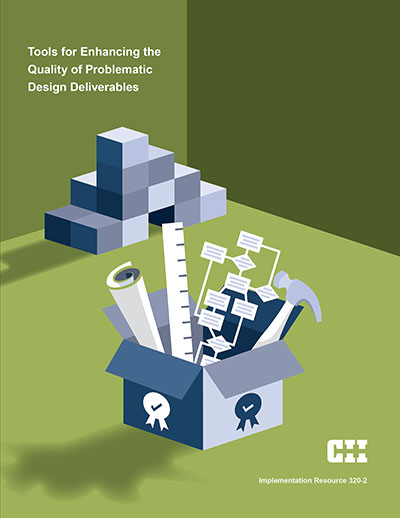
Study of Engineering/Design Deliverable Quality
Defects in Engineering/Design deliverables can cause significant design rework and/or construction phase rework, which lowers construction performance in terms of cost, schedule, and safety. But the construction industry does not successfully manage the Engineering/Design phase quality to eliminate design deliverable defects and quality remains a major challenge for capital projects. With this in mind, the Construction Industry Institute (CII) organized Research Team (RT) 320, Definition and Measurement of Engineering/Design Deliverable Quality, with the following goal:
“Develop a uniform definition and method of measurement for engineering/design deliverable quality, usable by project stakeholders such as owners, constructors/craft, equipment suppliers, and engineer/designers.”
RT 320 defined the research scope as the detailed design phase from Front End Engineering Design (FEED) validation to Final Issued-for-Procurement/Construction (IFP/IFC). The research team sought to assess design deliverable completeness, correctness, and design errors/omissions. Moreover, the research team agreed to exclude cost of design efforts and cost estimates based on engineering deliverables from the consideration. The research team also employed a bottom-up approach to determine design quality defects, impacts, causal factors, and metrics.
In order to identify the most problematic design deliverables, the research team conducted a literature review and had RT discussions to develop a list of 53 common Engineering/Design deliverables. Then, the list was reduced to the 11 most problematic deliverables by use of an industry survey that assessed the relative frequency of related design quality problems. The RT was able to collect 798 common defects associated with the 11 problematic deliverables. The final 73 common, significant design deliverable defects were identified by consolidating the 798 defects.
Next, the team analyzed 73 design deliverable defects for their causal factors, and for their associated leading and lagging indicators. In total, 349 causal factors were identified, which lead to the identification of 118 leading metrics and 23 lagging metrics. In addition, the research team was able to identify 266 completeness checklist items associated with the 11 Most Problematic Design Deliverables from published literature and from RT member company practices.
Following the 73 design deliverable defects analysis, the research team developed two implementation tools, the Design Deliverable Quality Assessment (DDQA) Tool and the Completeness of Design Deliverable Checklist (CDDC) Tool, to ensure high-quality and complete Engineering/Design deliverables. The primary objective of the DDQA Tool is to assess the current level of Engineering/Design deliverables quality. The CDDC Tool is used to assess the current level of Engineering/Design completeness.
Lastly, all the research products were validated and/or demonstrated by 24 external reviewers. Based on feedback, the research team re-examined content and modified products. From tool demonstrations, it was determined that the two tools can effectively contribute to project design quality, and the tools will likely be used on future projects. The research team believes that the tools can assist project stakeholders, such as owners, contractors, engineers, and designers, to foresee and ultimately avoid potential design quality issues.
Chapter 1 of this report provides an introduction to the Research Team (RT) 320. Chapter 2 summarizes findings from published literature, including previous CII research products. Next, the research methodology is described in Chapter 3 and Chapter 4 presents what was learned from CII Benchmarking data pertaining to design quality. Chapter 5 illustrates major findings of this research, such as the 11 Most Problematic Deliverables, design deliverable defects, metrics, and design deliverable completeness checklist. Chapter 6 describes objectives, inputs, and outputs of two implementation tools: the Design Deliverable Quality Assessment (DDQA) Tool and the Completeness of Design Deliverable Checklist (CDDC) Tool. Chapter 7 summarizes the external reviewers’ feedback comments and RT reactions. Lastly, Chapter 8 concludes the report with recommendations for future research. Details of research products, including a Defects Analysis Table, Metrics-Timing Table, and Deliverable Completeness Checklist, can be found in the appendices.



